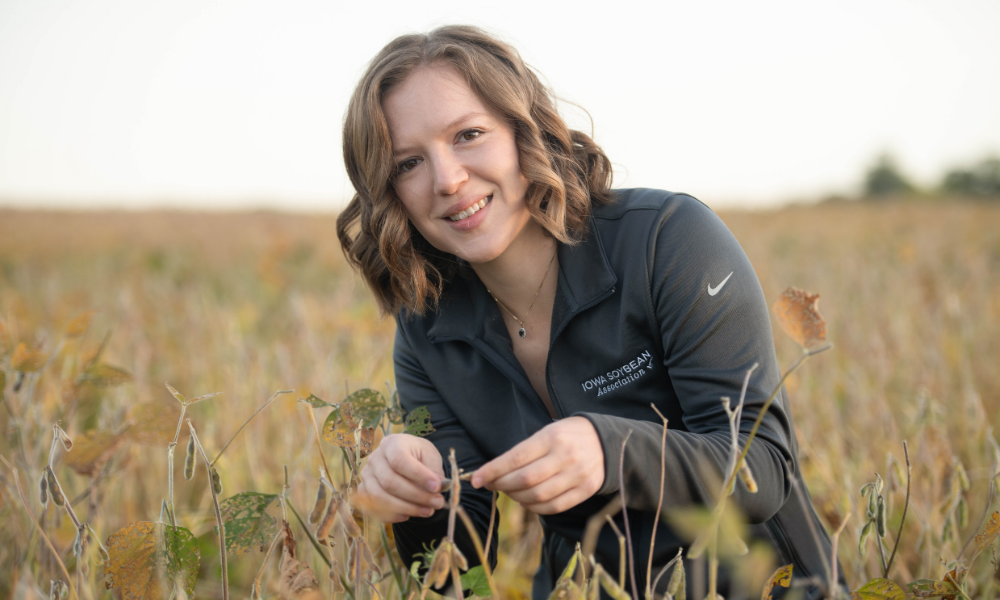
Teresa Middleton, ISA field services manager, utilizes YouTube and other digital content to spread the word about agronomic research.
Technology reaches farmers via virtual meetings, YouTube and more
January 20, 2021
Winter meeting season looks different this year as many traditional events that brought together large groups of people are being retooled. Instead of sitting in a meeting room, many farmers will be firing up Zoom.
The virtual landscape isn’t the same and usually not the preference. Still, today’s technology allows the Iowa Soybean Association (ISA) Research Center for Farming Innovation (RCFI) to take efforts online and continue working to meet farmers where they are.
“We strive to work directly with farmers to apply data and evidence-based solutions to cropping and livestock system challenges,” says Roger Wolf, RCFI director. “As we look to bring resources to them in more virtual ways, we know that farmers like the unbiased nature of research and the technical assistance offered.”
While the adjustment to virtual offerings is new for some farmers, Chris Gaesser is right at home learning from home.
The Corning-area farmer and member of the ISA Research Advisory Council is a self-described gamer and appreciates and capitalizes on online and virtual platforms.
“I’ve been playing against and communicating with other gamers from around the world for years and years,” Chris says. “For me, I do miss in-person meetings and research is my passion, but this is my element. I think (virtual options) will allow us to reach new and more diverse farmers and future leaders.”
Info exchange based on preferences
Scott Nelson, RCFI senior field services program manager, understands the need to adjust information delivery.
“Farmers have different personalities and learn in different ways,” Nelson says. “Some are very data driven, while others prefer simple recommendations. Other farmers prefer to digest information via written communication. However, a growing number of farmers tell me they prefer online webinars and YouTube videos.”
Nelson is taking that feedback and running with it, already taking information virtual. Last summer, his annual 4R event was offered via YouTube. And the offering connected with all 4Rs, which represent right source, right rate, right time and right place. The information is accessible to all farmers on the ISA website.
Last month, he hosted an ISA webinar focused on recent water monitoring results and a deep dive into putting field-level information, such as yield, soil texture, seeding rates and fertility rate adjustments, to work to strengthen farm profitability. The webinar also reviewed some new ISA research on management practices for corn after cover crops. The study showed a 10- to 20- bushel advantage for cover crops with improved management compared to the no-cover crop control at three sites in 2020. This ISA study will be repeated in 2021, and the team is actively seeking participants.
From field to farmer screens
On a personal level, Teresa Middleton, ISA field services manager, looks to YouTube and online resources for information.
“I love to sew and crochet,” she says. “Often, I turn to YouTube as a go-to resource when trying to understand a new stitch. Video captures our attention and is an easy way to learn. It’s another tool in the toolbox.”
Middleton is putting that tool to use for farmers, recently working with ISA Communications Director Joe Murphy on an in-the-field video with Story County farmer Pat Murken.
“I wanted to share the information he’s learning from the cover crop project. When I approached him with the video idea, he was on board,” says Middleton.
Murken has been planting cover crops for many years and will work with Middleton to conduct a time of termination trial this spring, to determine the difference in biomass and nitrates in the soil and soil compaction levels. Murken will terminate half of his cover crop strips a couple of weeks before planting his cash crop and the other half at or just after planting.
Middleton and Murken look forward to understanding if the extra two weeks of growth will allow the roots to hold back more nitrate in the spring without a detrimental effect on yield.
“That data will help us work with others to study cover crop termination times and determine how much more cover crop biomass we can get away with to maximize soil health and other benefits,” says Middleton. “It’ll be exciting to see.”
They plan to shoot a follow-up video this spring.
“It’s a great experience to take these trials and be creative in how we present the process and progress,” she adds. “There is a lot of work to creating video, and it’s been a rewarding and collaborative process with Pat and the ISA team. I think it allows us all to keep learning and striving to be relevant and timely with our offerings to our members.”
This story was originally published in the January 2021 issue of the Iowa Soybean Review.
Back